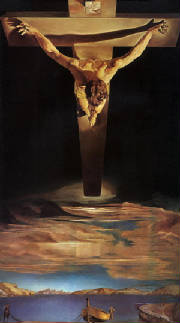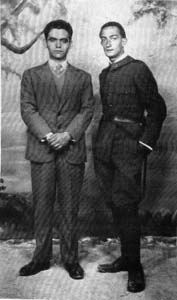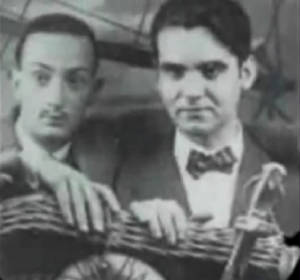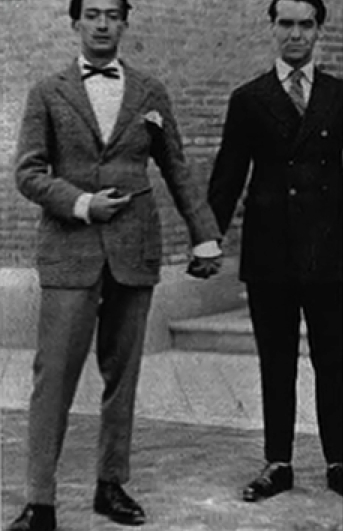|

Arte,
Romance y Tragedia.
Dos de los siglos 20 más famoso artista y poeta.
Two of the 20th Centuries Most Famous Artists and Poets
Dali and Lorca first met while they were both attending art school. The two artistic powerhouses formed both an intimate
and artistic passion for one another.
Lorca
Born on June 5, 1898, in Fuente Vaqueros near
the city of Granada, the son of a liberal landowner, Federico García Lorca's
creativity would rear its head early. As a child, he was known to carry on
conversations with inanimate objects, bestowing upon each object a personality
and speaking with them as if they were living things and might speak back at
any moment. As a child, he studied music, an activity which enhanced his
natural sense of rhythm, and in his late teens, he began to write poems which
he would recite in local cafés.

Dali Salvador Felipe Jacinto Dali I Domenech was born at 8:45 on the morning of May 11, 1904 in the small agricultural
town of Figueres, Spain. Figueres is located in the foothills of the Pyrenees, only sixteen miles from the French border in
the principality of Catalonia. The son of a prosperous notary, Dali spent his boyhood in Figueres and at the family's summer
home in the coastal fishing village of Cadaques where his parents built his first studio. As an adult, he made his home with
his wife Gala in nearby Port Lligat. Many of his paintings reflect his love of this area of Spain. The young Dali attended the San Fernando Academy of Fine Arts in Madrid. Early recognition
of Dali's talent came with his first one-man show in Barcelona in 1925. He became internationally known when three of his
paintings, including The Basket of Bread were shown in the third annual Carnegie International Exhibition in Pittsburgh.

|
| DALI & LORCA |
The History They Don't Teach
There
was an odd if not curious nature to the two men’s attraction to one another; perhaps because the enigmatic Dali found
it all-important to figure out those things in his environment of an unknown quality, Lorca filled that category nicely. In
Lorca, Dali saw a strong masculine, forceful and artistic supporter, with avant-garde views and most importantly Lorca was
not a real competitor to Dali’s overly vain and demanding nature and temperament. In highly homophobic 1920’s
Spain, the life of known homosexuals would be coarse and brutal, often killed in jails. The early art school behavior between
the two was at first demure and circumspect in matters of homosexuality. For their own safety they were part of the new Republicans
coming of age. (Socialists – anti-monarchists – anarchists, poets, artists and political organizers) And working
in either the spoken word or through pigment Dali and Lorca did help define an entire cultural movement in Spain, and in Dali’s
dada-surrealism a world cultural event. Static, conventional art would never be the same.

Lorca became one of the poets of Socialist
Republican Spain, which in the end would seal his death after Franco took over Spain by force. Lorca was captured by the Spanish
fascists, made to dig his own grave, and then with other patriots was shot. Dali had already by the Civil War moved from politics
and on to other men and a very important woman who was the handmaiden of Dali’s success. Dali was never timid about
his homosexuality but his interests were not just physical but a process by which he tried to insert his lived experience
through another, as mineral, vegetable or human. I believe you can see that especially strongly in his later surrealist works. Don Noyes-More Ph.D., Editor in Chief.
LORCA HISTORICAL FILM
Romance
De La Luna
La
luna vino a la fragua
con
su polisón de
nardos.
El
niño la mira mira.
El
niño la está
mirando.
En
el aire conmovido
mueve
la luna sus
brazos
y
enseña, lúbrica y
pura,
sus
senos de duro
estaño.
Huye
luna, luna, luna.
Si
vinieran los
gitanos,
harían
con tu corazón
collares
y anillos
blancos.
Niño,
déjame que
baile.
Cuando
vengan los gitanos,
te
encontrarán sobre
el yunque
con
los ojillos
cerrados.
Huye
luna, luna, luna,
que
ya siento sus
caballos.
Níno,
déjame, no pises
mi
blancor almidonado.
El
jinete se acercaba
tocando
el tambor del
llano
Dentro
de la fragua el
niño,
tiene
los ojos
cerrados.
Por
el olivar venían,
bronce
y sueño, los
gitanos.
Las
cabezas levantadas
y
los ojos entornados.
¡Cómo
canta la zumaya,
ay
cómo canta en el
árbol!
Por
el cielo va la
luna
con
un niño de la
mano.
Dentro
de la fragua lloran,
dando
gritos, los
gitanos.
El
aire la vela, vela.
El aire la está velando.
___
Thank You to the Following:
The Dali Museum, St. Petersberg FL. ( http://salvadordalimuseum.org ) The National
Museum of Contemporary Art The Los Angeles Central Library The Hirshorn Museum, Washington D.C. Librería Garcia Lorca Wikipedia

|

